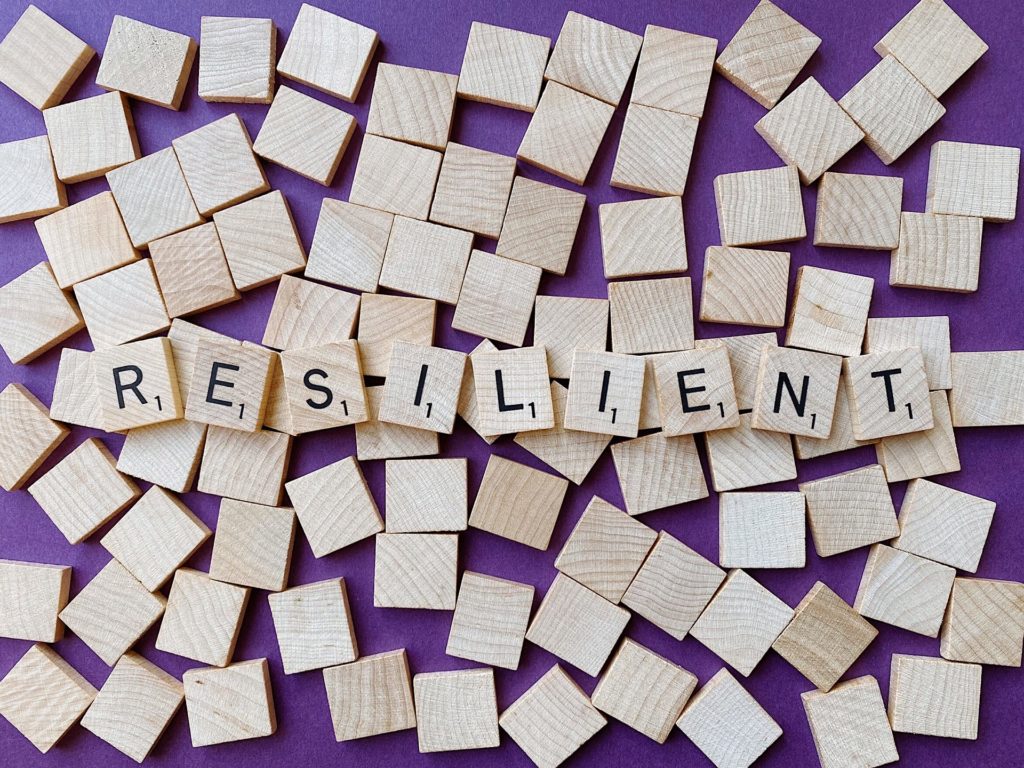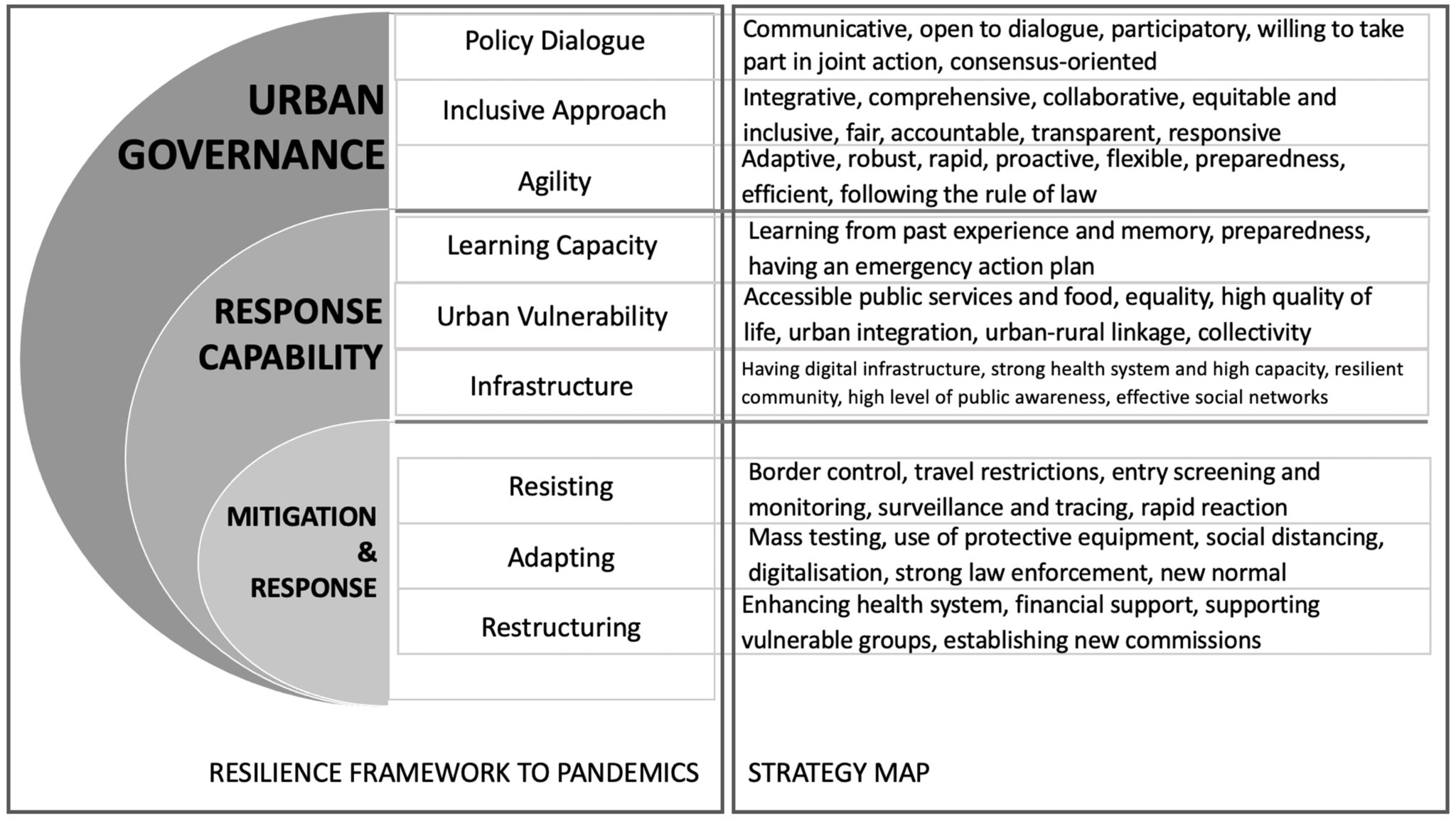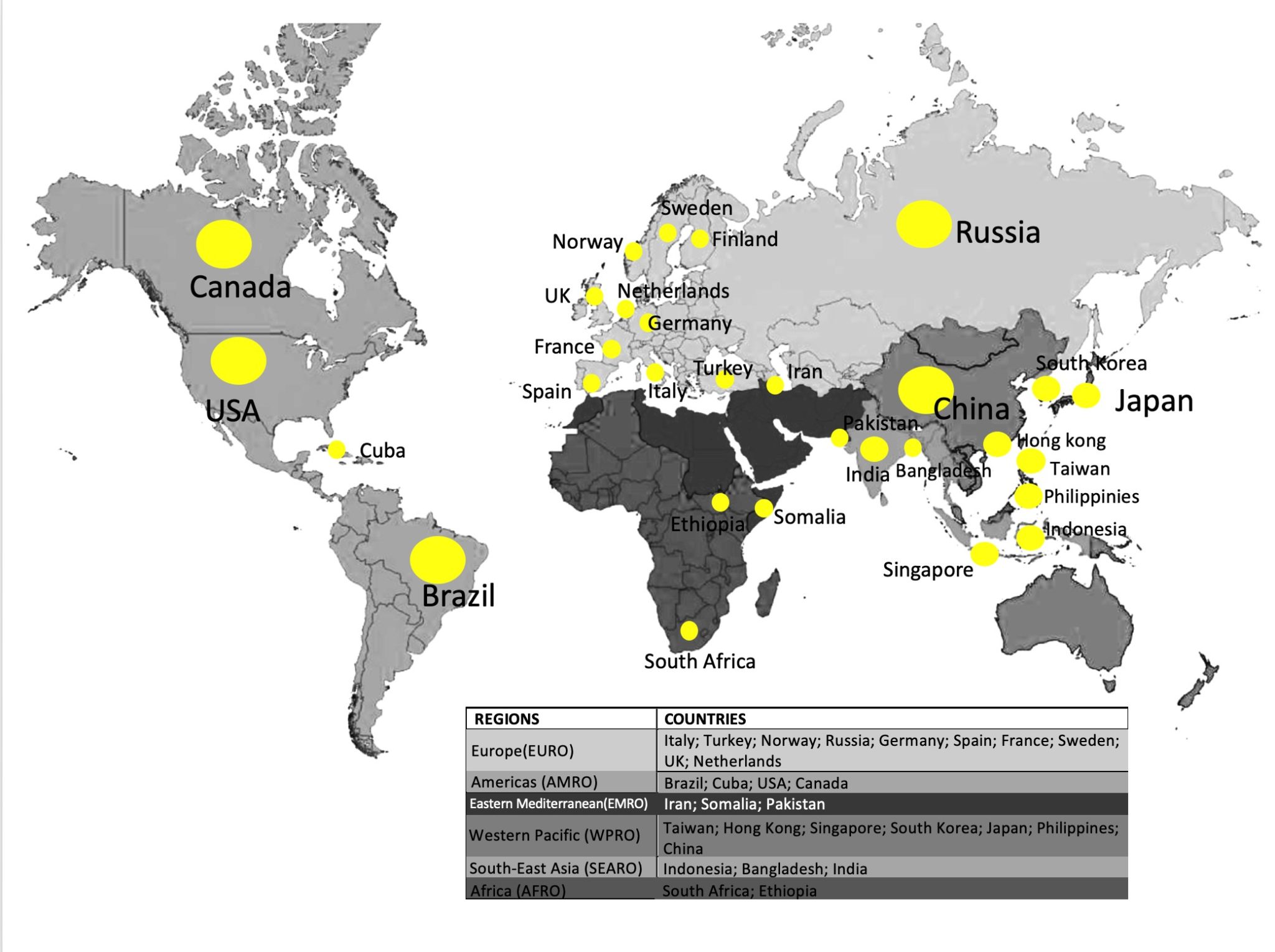Harnessing Covid-19 Experiences in Pandemic Regions for a Tentative Framework of Urban Resilience

DOI reference: 10.1080/13673882.2021.00001108
By Aysun Aygün Oğur (email), Pamukkale University, Turkey, Ebru Kurt Özman (email) , University of Amsterdam, the Netherlands and Zeynep Özdemir (email), Amasya University, Turkey
This article examines the practices and approaches taken by different countries with a high number of cases and distinctive responses to the Covid-19 outbreak within six World Health Organization (WHO) regions (Figure 2) from the perspective of urban resilience. The six regions in question represent the WHO’s organizational-purpose grouping with geographical terms, which is the way the WHO publishes its statistics. Pandemic resilience literature takes a fragmented approach to specific management areas or adaptation strategies. Findings suggest the need for a comprehensive approach that covers the different perspectives of resilience. Thus, this paper offers a tentative conceptual framework consisting of prominent factors including a strategy map, which might enable a broader perspective to guide recovery from future pandemics.
Resilience Thinking to the Pandemic
Considering various resilience definitions in the literature, this paper approaches urban resilience from a risk management perspective and perceives urban resilience as a system’s capacity to reduce susceptibility, absorb disturbance, resist, respond, adapt, recover, reorganise, and bounce back from any unexpected external stresses while continuing to function in the face of uncertainty (Godschalk, 2003; Lhomme et al., 2013; Wamsler et al., 2013; Diaz-Sarachaga and Jato-Espino 2019).
The resilience approach defines new priorities and principles to increase the adaptive capacity of the system to sudden changes (Eraydin, Taşan-Kok,2013). The role of resilience in the case of a pandemic is the way regions, cities, or communities handle disruptions. Resilience can be evaluated in relation to prevention, early warning, response, and recovery stages (Pan et al., 2020) when infrastructure and health service capacities, spread of disease, vulnerable populations, and late responses to mitigate the spread have been the major challenges (Cheshmehzangi, 2020).
It is critical to developing links between resilience thinking theory and practice (Coaffee et al., 2018), especially in a global crisis such as a pandemic. In this study, the practices of how different countries responded to the Covid-19 outbreak are discussed through the lens of resilience literature. The discussion framework is constructed on three relational concepts based on the definition of urban resilience and the challenges of the pandemic. To evaluate each countries’ capacity to resist, respond, adapt, recover, and reorganise, challenges are investigated under “mitigation and response,” in an effort to assess their capacity to reduce susceptibility and absorb disturbance in the structures of countries examined under “response capability”, and to inspect their capacity to bounce back. Management approaches are reviewed under “urban governance” concepts (Figure 1).
Figure 1: Strategy Framework of Resilient Regions and Communities Against Pandemics

How different countries experienced Covid-19 are analysed from phenomenological data analysis through a resilience perspective. Data were obtained by desk research based on a significant number of written discussions, newspaper articles, and literature related to Covid-19. Through this methodology, prominent factors that explain and categorise the practices related to resilience concepts and strategies are derived by answering two questions: What did countries experience? and how did they experience Covid-19? The case study cities were selected from six pandemic regions considering diversity in terms of practices to compare and reveal the different approaches adopted in pandemic management (Figure 2).
Figure 2: WHO regions and case countries.

Mitigation and Response
The initial actions were taken against the Covid-19 pandemic aimed at preventing large-scale cluster transmission, decreasing the number of deaths, and “flattening the curve”. These were containment measures applied to “Resist” the spread of the virus. Since then, the spread of the virus has required “Adaptation” measures and finally, governments and communities have needed to “Restructure” their systems and services.
- Factor 1: Resisting
The initial measure to prevent or delay the emergence of coronavirus infections between countries/cities aimed to gain time for planning, enhance capacity, and learn from other countries’ experiences (WHO, 2017). International travellers were initially suspected of carrying the virus from one region to another. Therefore, travel restrictions were put in place and passenger controls were implemented to reduce transmission. The first countries and regions to put travel restriction measures in place were those geographically close to China such as Taiwan and Hong Kong (Deutsche Welle, 2020a). Until the first case emerged, Italy was among the countries that continued to allow flights to continue. This can be considered as a late reaction given the dramatic increase in infections registered by Italy in early March (McCann et al., 2020). Turkey restricted travel early and the country gradually closed its borders to high-risk countries, therefore delaying the spread of the virus until mid-March 2020 (Aytekin, 2020). Countries such as Brazil and Indonesia, which denied the importance of the pandemic and refused to implement travel measures, suffered from an accelerated spread (Phillips, 2020). Surveillance is another important strategy to track the spread within communities. Following Singapore’s move, Norway, South Africa, and Russia announced national applications to track the risk level of people, contacts and to warn people (Goggin, 2020).
- Factor 2: Adapting
The pandemic has changed daily routines and behaviours and has prevented close contact among people (Sun and Zhai, 2020). The adaptation factor investigates measures taken to adapt to the new circumstances to prevent rapid virus transmission and to ease the stress on the health system. South Korea, Taiwan and Cuba have been frontier countries when it comes to organising mass testing programmes and isolating infected people. Hong Kong, Japan, and Singapore developed and implemented their own nationwide Covid-19 diagnosis tests (Wired, 2020). On the other hand, countries with low testing capacity, for example, the Philippines and Bangladesh, couldn’t prevent the spread as they couldn’t detect the number of infected people. Germany, Italy, Spain, and France first announced social distancing measures that prohibited gatherings and social activity in March 2020. These measures were then extended to regional or national lockdowns in many countries (Deutsche Welle, 2020b). Taiwan was an exception when it came to managing the Covid-19 outbreak, as recurring lockdowns were not used; instead strong surveillance, isolation, and testing strategies (Sui, 2020) were put in place.
- Factor 3: Restructuring
A complementary factor to adaptation, restructuring refers to the institutional, social and financial re-organisation of systems, including health services, financial resources, initiatives to support vulnerable groups and communities. Accessibility to beds, the capacity of intensive care units, and of health system capabilities have been the most severe aspect of this crisis. To manage this, countries such as Turkey, the US, and Spain established large field hospitals in temporary locations (Thompson, 2020). Strict measures created a global economic crisis. Germany, China, France, Italy, and the US all announced support packages for local public investment, infrastructure enhancement, economic development assistance and medical equipment. SME’s and self-employed people were also supported by governments, either through cooperation with banks, as in France, or by public funding programmes, as in Italy (OECD, 2020). Some countries established new commissions to plan and coordinate Covid-19 management and recovery processes such as the “National Coronavirus Command” in South Africa, or the various national health advisory boards in some European countries.
Response Capability
The “Response Capability” concept focuses on the qualifications that regions should have to be more resilient in the face of a pandemic. From this perspective, three main Response Capabilities factors emerge: “Learning Capacity” covers knowledge, past experience, memory and preparedness in order to increase the capacity of continuing, adapting and changing in case of stress factors in urban systems (Galderisi, 2014); “Urban Vulnerability” examines the level of urbanisation and socio-economic aspects, rural and urban density, development and informality that affect the ability of individuals and communities to cope with risks and future uncertainties (Jabareen, 2013); and finally “Infrastructure” discusses functional and social networks.
- Factor 1: Learning Capacity
There are valuable lessons to be learned from the Covid-19 management approaches adopted by China, Singapore, Taiwan, and South Korea, which were able to take rapid, comprehensive, preventive measures (Wired, 2020). The common characteristic of these countries was to implement emergency action plans that were previously developed to deal with SARS and Ebola (Weforum, 2020). According to the Global Health Security Index (2019) scored all countries related to their biological safety and preparedness for disease based on compliance with international norms on diseases and the variables of general political, economic and environmental risk. No country was prepared for something like Covid-19 but Germany, France, the Netherlands, Finland and Canada were among the best equipped owing to their stable political systems, strong socio-economic structures and solid infrastructure (GHSIndex, 2020; Kiersz, 2020).
- Factor 2: Urban Vulnerability
Socio-economic structure and the development level of countries determine the degree of a community or a system’s susceptibility to any external stresses such as a pandemic. Strength to combat Covid-19 can be revealed by analysing the situation of informality, access to services and the poverty level of countries and communities. Informal settlements where health, transportation, housing, and other public services are inadequate correspond to the most vulnerable regions to Covid-19. Waste management, insufficient housing conditions, and difficult access to basic needs such as water and food create difficulties in controlling transmission in these regions (Mitlin, 2020; UNHabitat, 2020).
Poor housing conditions in informal settlements with high household sizes make it difficult to maintain social distance, for example, in Manila and the Philippines (UNHabitat, 2020). ‘Stay at home’ campaigns may produce benefits to groups with separate rooms within a house, but not for those who share flats, multiple families sharing a roof in slums, and urban areas that have high homeless and vulnerable populations, such as in Dharavi, which is India’s largest unofficial settlement (Petersen and Rahman, 2020). Vulnerable groups with low incomes sustain their lives without regular working schedules, for example, people who live in Brazil’s favelas. For them, “stay at home” wasn’t an option (Rioonwatch, 2020).
- Factor 3: Infrastructure
Hard infrastructure focuses on the suitability of healthcare systems and health capacity, and rapid solutions applied by digital infrastructure to cope, while soft infrastructure addresses social concerns such as a sense of community/individual responsibility, and public awareness. The critical importance of healthcare systems/health capacity has come to the fore during the pandemic. Germany is in a relatively better position than other countries in combating the pandemic due to having the highest bed capacity per population in Europe (8.0 hospital beds per 1,000 inhabitants) along with the health sector’s decentralized structure that ensures high accessibility (Covid-19 Healthsystem, 2020). South Korea, Singapore and Hong Kong decreased the number of cases in the early stages of the outbreak and flattened the curve through the efficient response of health systems (Kamal et al., 2020).
Underdeveloped countries such as India, the Philippines, Indonesia, Pakistan, Ethiopia, Bangladesh, Africa, and Somalia (Deep Knowledge Group, 2020) suffered from an inefficient health infrastructure and a lack of resources to combat the virus (Frank and Grady, 2020). Technology and artificial intelligence are significant when it comes to adapting to a “new normal”. China, South Korea, and Singapore used robots, drones and big data to manage outbreaks, disinfect hospitals and provide supplies (Chandran, 2020). Sense of community and individual responsibility are part of the soft infrastructure and are two important factors in preventing the rapid spread of the virus. Countries such as Singapore and Sweden have a high level of awareness and a strong sense of community and have easily adapted to social distancing, wearing protective masks and other hygiene measures (Wired, 2020). Citizens of developed Asian countries obey social distance rules due to cultural influence owing to lessons learned from previous experiences and they already have a strong sense of personal zones (Cheung, 2020).
Urban Governance
This concept considers which strategies make policies more successful, and how governance needs to be designed to manage pandemics. Following the factors of this concept, which have been designed considering principles of good governance (Sheng, 2009), will ensure urban governance resilience will be more communicative within ‘policy dialogue’ among different levels of governments, more equitable within ‘inclusive approach’, and more flexible within ‘agility’.
- Factor 1: Policy Dialogue
Participatory and consensus-oriented principles of good governance (Sheng, 2009) are complementary to this factor. According to the OECD (2020), ensuring and strengthening continuous/regular dialogue among different levels of institutions through “vertical and horizontal coordination” is one of the first and crucial steps to manage the impacts of Covid-19. Canada and South Korea are countries providing “vertical coordination” between different levels of governments through a “whole-of-government action/approach” by defining guiding principles and core values in response to Covid-19 (OECD, 2020). “Horizontal policy dialogue” in Sweden has been conducted through cooperation across municipalities to buy protective equipment with half a billion in credit given by the government (Council of Europe, 2020). Cooperation in the US has been on a regional level between states (New York State, 2020). A protocol was published in Ethiopia under the leadership of MOLSA and after consultation with employers’ and workers’ organizations separately. While restrictions on formal meetings continue in Iran and Somalia, social partners seek joint actions and seek to constitute any policy dialogue through ongoing informal discussions (ILO, 2020).
- Factor 2: Inclusive Approach
It matters to design and execute processes in the most transparent and accountable way possible by considering the principles of good governance. Canada has provided support to the homeless through the Reaching Home Program at a federal government level, and to First Nations and Inuit communities through ISC on provincial and municipal levels. Italy has collaborated with 8,000 municipalities to deliver food vouchers to people in need. Fiscal support to local governments and homeless providers in the US regarding the needs of vulnerable populations comes from the CARES Act’s budget for Emergency Solutions Grants (OECD, 2020). Transparent communication between citizens and government is an important factor against misinformation and rumour. In Taiwan, a non-profit organisation called Fact Check Center helped inform the public about misinformation before these rumours emerged (Deutsche Welle, 2020a).
Iran’s government punished people who spread information about a serious epidemic due to the political interests of the government (Evans, 2020). Implementation of “TB clubs” and “TB strategies” in the urban areas of Ethiopia and India (Galea et al., 2005) were successful experiences of “joined up governance”, which was achieved through “a more holistic view of urban governance, broad political commitment, cross-sectoral planning, and community participation” (Montgomery, 2009). Citizen mobilization for policy responses worked in Brazil. On 20 March, a group of NGOs began a campaign to request 287 US$ per family as an urgent package especially for informal workers and favela residents (Rioonwatch, 2020). AHBAP, a cooperation and solidarity network platform in Turkey, developed a Covid-19 portal to provide accommodation for health workers and to support education, street animals, and employees in need from different sectors.
- Factor 3: Agility
Effectiveness, efficiency, and rule of law are among the major principles of good governance, which fit and contribute to the factor of agility. Having robust governance allows regions and communities to be adaptable and agile enough to maintain a specific goal or function (Ansell et al., 2020). After learning from previous epidemics (SARS and H1N1), Singapore established a robust system to monitor and control outbreaks, as did South Korea and Taiwan (Wired, 2020). Robustness is more about managing processes. Taking decisive actions rapidly is one of the major strategies to achieve ‘agility’.
The government of Taiwan anticipated that the demand for masks and testing kits would increase and invested in production by acting rapidly. This policy was also adopted by South Korea and France (Deutsche Welle, 2020a). Being flexible in processes, regulations, institutions, and systems matters results in an efficient response to Covid-19. While China has provided flexibility on regulations regarding governing land such as rent and payments in over 60 cities, South Korea has facilitated the supply of special health equipment through an active administrative system (OECD, 2020). The UK government confirmed regulations such as easing restrictions on supermarket deliveries, postponing upcoming elections until May in 2021, and flexibility on the legislation of annual council meetings (UK Government, 2020).
Conclusion
This paper reveals the key role of comprehensive and integrated approaches to building more resilient regions through analysing Covid-19 experiences. As Covid-19 outbreaks continue into 2021, it is crucial to extract a comprehensive understanding from previous experiences. When the strategies achieved by the concepts above are considered, the points in Figure 3 come to light.
Figure 3: Lessons learned when building resilience

Although the socio-economic development level is an important issue in combatting stresses, this study reveals that there are unique and efficient approaches that contribute to process management regardless of development level. As a final remark, while Western Pacific cases outshine with learning capacity, South-East Asia and Africa cases come forward with “collective action” despite the vulnerable structure. In the cases of the Eastern Mediterranean, weak dialogue for policy makes governance of the pandemic hard while the opposite can be observed in the Americas. Financial support in European cases eases to adapt and restructure the urban system. This study is important for developing a non-biased perspective that focuses not only on prominent practices but also embedded approaches in regions with diverse structures.
References
Ansell C., et al. (2020). ‘The COVID-19 pandemic as a game changer for public administration and leadership? The need for robust governance responses to turbulent problem’. Public Management Review, 1-12.
Aytekin E. (2020). ‘Turkey acted faster than Europe in tackling COVID-19’
Chandran R. (2020). ‘From food to tech, Covid-19 to spur urban planning rethink’.
Cheshmehzangi, A. (2020). ‘The City in Need: Urban Resilience and City Management in Disruptive Disease Outbreak Events’. Springer, Singapore.
Cheung H. (2020). ‘Coronavirus: What could the West learn from Asia?’.
Coaffee, J., et al. (2018). ‘Urban resilience implementation: A policy challenge and research agenda’
Council of Europe (2020). European Committee on Democracy and Governance and COVID-19_Norway.
Covid-19 healthsystem (2020). Providing Health Services Effectively.
Deutsche Welle (2020a). How has Taiwan kept its coronavirus infection rate so low?.
Deutsche Welle (2020b). Coronavirus: What are the lockdown measures across Europe?.
Diaz-Sarachaga, J. M., and Jato-Espino, D. (2019). ‘Do sustainable community rating systems address resilience?’ Cities, 93, 62-71.
Eraydin, A. and Taşan-Kok, T., (2013). Introduction: Resilience Thinking in Urban Planning. A. Eraydin and T. Taşan-Kok (eds.), Resilience Thinking in Urban Planning, GeoJournal Library 106.
Evans Z. (2020). ‘Iran to Sentence Citizens Who “Spreads Rumors” about Coronavirus to Flogging, Three Years in Prison’.
Frank A. and Grady C. (2020). ‘Phone booths, parades, and 10-minute test kits: How countries worldwide are fighting Covid-19’.
Galderisi A. (2014). ‘Urban resilience: A framework for empowering cities in face of heterogeneous risk factors’. A/Z ITU Journal of the Faculty of Architecture 11(1): 36–58.
Galea S., et al. (2005). ‘Cities and population health’. Social science & medicine (1982) 60(5): 1017–1033.
GHSIndex=The Global Health Security Index (2020). 2019 Global Health Security Index.
Godschalk D.R. (2003). ‘Urban hazard mitigation: Creating resilient cities’. Natural Hazards Review 4(3): 136–143.
Goggin G. (2020). ‘COVID-19 apps in Singapore and Australia: reimagining healthy nations with digital technology’. Media International Australia 177(1). SAGE Publications Ltd: 61–75.
ILO=The International Labour Organization (2020). COVID-19 and the world of work, Country policy responses.
Jabareen Y. (2013). ‘Planning the resilient city: Concepts and strategies for coping with climate change and environmental risk’. Cities: 220–229.
Kamal R., et al. (2020). ‘How prepared is the US to respond to COVID-19 relative to other countries?’ Health System Tracker. 27 March, 2020
Kiersz A. (2020) ‘The 20 countries in the world best prepared for an epidemic like coronavirus still aren’t really all that ready’
Lhomme, S., et al. (2013). ‘Urban technical networks resilience assessment’. In R. Laganier (Ed.), Resilience and urban risk management, 109–117. London: CRC Press.
McCann A., et al. (2020). ‘Italy’s Virus Shutdown Came Too Late. What Happens Now?’.
Mitlin D. (2020) ‘Dealing with COVID-19 in the towns and cities of the global South’
Montgomery M. (2009). ‘Urban poverty and health in developing countries’. Popul. Bull. 2009, 64, 1–16.
New York State (2020). ‘Pennsylvania Joins New York, New Jersey and Connecticut’s Regional Coalition to Combat COVID-19’.
OECD=The Organisation for Economic Co-operation and Development (2020). ‘The Territorial Impact of COVID‐19: Managing the Crisis across Levels of Government’.
Pan S., et al. (2020). ‘Revelation of Wuhan City’s Response to COVID-19 Pandemic on Urban Resilience Enhancement’. Journal of Emergency Management and Disaster Communications. 1(1) 1–14.
Petersen H.E. and Rahman S.A. (2020). ‘We are very afraid’: scramble to contain coronavirus in Mumbai slum’.
Phillips T. (2020). ‘Jair Bolsonaro claims Brazilians ‘never catch anything’ as Covid-19 cases rise’.
Rioonwatch (2020). ‘Covid-19 Unmasks the Privilege of Isolation in Rio de Janeiro and All Brazil’.
Sheng Y.K. (2009). ‘What is good governance.’ United Nations Economic and Social Commission for Asia and the Pacific.
Sui C. (2020). ‘In Taiwan, the coronavirus pandemic is playing out very differently. What does life without a lockdown look like?’.
Sun C. and Zhai Z. (2020). The efficacy of social distance and ventilation effectiveness in preventing COVID-19 transmission’. Sustainable Cities and Society, 62.
Thompson T .(2020). ‘From Fields to Field Hospitals’. ESPN, 2020.
UK Government (2020). ‘Robert Jenrick Reaffirms Support for Councils in their Coronavirus Response’.
UNHabitat (2020). ‘Opinion: Local governments are in the frontline of coronavirus response’.
Wamsler, C., et al. (2013). ‘Planning for climate change in urban areas: From theory to practice’. Journal of Cleaner Production, 50, 68–81.
Weforum (2020). ‘How cities around the world are handling COVID-19 – and why we need to measure their preparedness’.
WHO=The World Health Organization (2017). ‘Pandemic Influenza Risk Management’.
Wired (2020). ‘Singapore Was Ready for Covid-19—Other Countries, Take Note’.
About the authors
Aysun Aygün Oğur completed her Ph.D. titled “Impacts of Climate Change on Tourism Sector in Turkey: Challenges and Future Prospects” in February 2021. Currently she is working as Research Assistant at Pamukkale University, Architecture and Design Faculty, City and Regional Planning Department at Denizli, Turkey. Her research interests are climate change, adaptation and mitigation, strategic planning, urban resilience, regional planning, and development. She is a member of AESOP Young Academics Network.

Ebru Kurt Özman continues her Ph.D. research in Urban Planning at the University of Amsterdam, The Netherlands. Her research investigates the relationship of entrepreneurial governance and policy networks in “mega” urban regeneration. Currently, Ebru is working as a researcher of the ORA-funded project WHIG as part of the Amsterdam team. She is also a trainer at the Green Certification for Buildings and Settlements YeS-TR Training Program, and a member of the Urban Governance Research Network (UGoveRN).

Zeynep Özdemir has a Ph.D. about “Definition of urban conservation site features by spatial statistical methods” and she works as a Research Assistant at Urban and Regional Planning Department of Amasya University, Turkey. Her research interests cover different fields including planning urban conservation, urban sociology, urban design, migration, and spatial analysis.
